A new operatic work with an original story is a joy to anticipate, and Santa Fe Opera’s World Premiere of The Righteous is to be applauded for its bountiful creativity and aspirations.
Composer Gregory Spears (Fellow Travelers) and librettist Tracy K. Smith (former Poet Laureate) have set out to make a compelling statement about the ruinous outcome of the intersection of politics and religion, and the corrupting influence those clashing factions can have. That certainly resonates in today’s America.
Beginning in 1980, The Righteous follows the evolution of the central character David, from his start as a charismatic church leader, to a convenient marriage, to marital infidelity, to political success, and to eventual moral bankruptcy by the 1990’s. While Ms. Smith’s nuanced dramatic writing offers quite solid character development, the piece attempts more social commentary than it delivers and the sobering issues of drug use, the AIDS crisis, theocracy, homosexuality, drug addiction, and racial divides sometimes came off as underdeveloped bullet points. And the late-in-the-game introduction of a gender gap subplot felt tacked on and distracting and was soon skipped over.
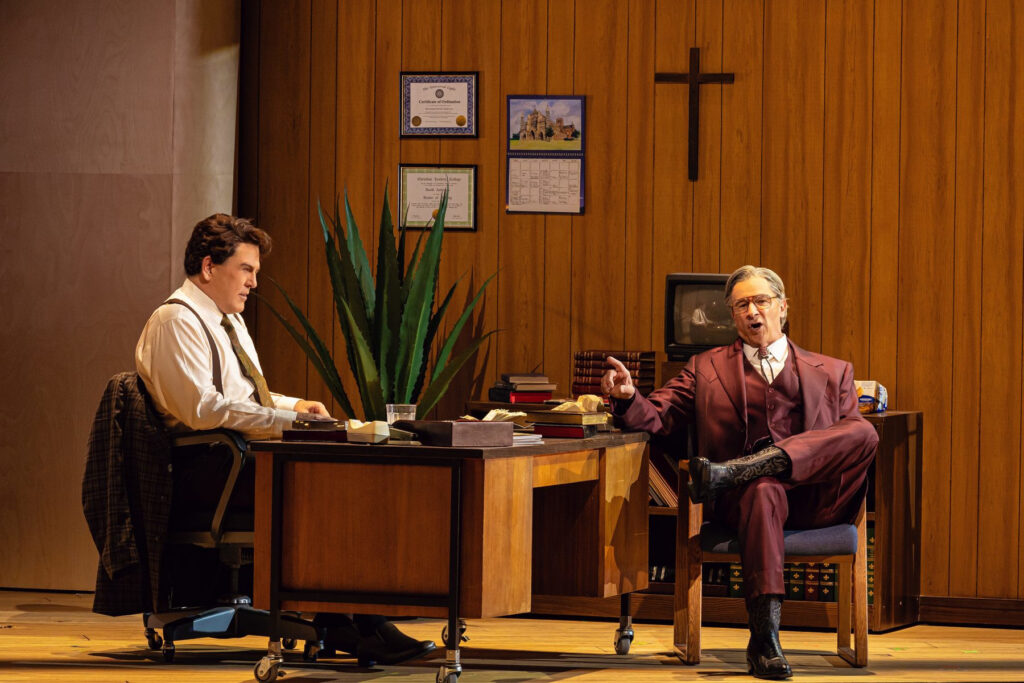
Mr. Spears’ score for large orchestra, large chorus, and seventeen soloists was quite virtuosic in its approach, perhaps too virtuosic. The churning, restless instrumental ensembles too often covered up the ends of low-pitched vocal lines, especially in much of Act I. The word-setting began by alternating hymn-like effects with a dark musical commentary, quickly giving way to rather angular and ungrateful vocal lines that were quite rangy in their demands. The score’s initial bombast did not always mesh well with the librettist’s gentler intent.
When the busy-ness eventually eased into a compelling soprano aria, it was all the more effective for its accessibility and serenity of approach. While Spears’ sound palette is distinctive and effective, there are nods to Copland and Bernstein; Britten, especially the brass licks from The War Requiem; and there are neo-classical echoes with occasional vocal filigree and ornamentation that hint at Stravinsky (whose bust is out on the terrace).
Overall, the numerous arias proved to be satisfying aural oases that gave considerable pleasure and explored inner feelings in concord with Metastasian ideals. It must be said there were many thrilling moments of ravishing sweep and beauty, and the ostinato figures, tumbling motifs, and moments of repose were significant and plentiful.
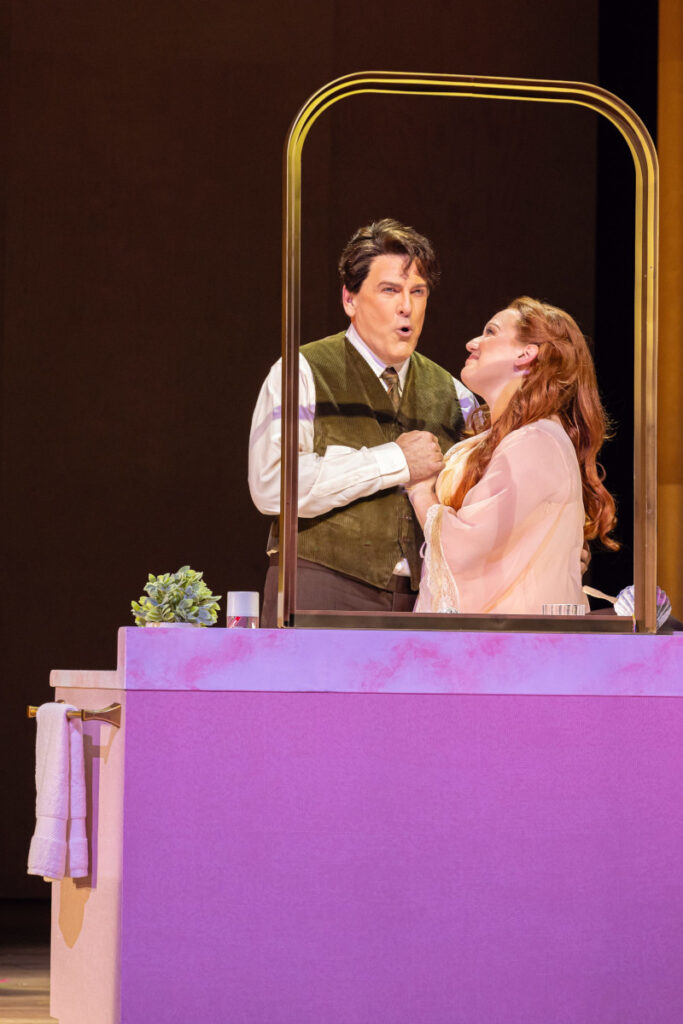
Conductor Jordan de Souza worked wonders with this massive score, and the orchestra played magnificently under his baton. In addition to beautifully judged ensemble moments throughout, the numerous exposed solos were rendered with character and flair. Maestro de Souza, meticulously cued the singers, and crafted a unified whole that had a potent arc, making the best possible case for the work’s premiere outing.
Director Kevin Newbury and his creative team were in lockstep with de Souza, ensuring that the production values were top tier. Mimi Lien’s set design was a visual delight. The stage was flanked by floor to ceiling beige panels the could rotate to open, close or subtly redefine the playing space. It is no easy feat to suggest all of the multiple settings required, but Ms. Lien has wholly succeeded using fluid, almost cinematic cross fades of furniture and props.
Japhy Weidemann greatly enhanced that effect with his detailed lighting design which showcased well considered color washes, atmospheric area lighting and a profusion of tight isolated specials. Devario Simmons has crafted a parade of spot-on costumes that captured the essence of the era and greatly helped define the characters. Projection and video designer Greg Emetaz completes this Dream Team with his usual refined and evocative work that does the Yeoman’s job of communicating the leaping passages of time.
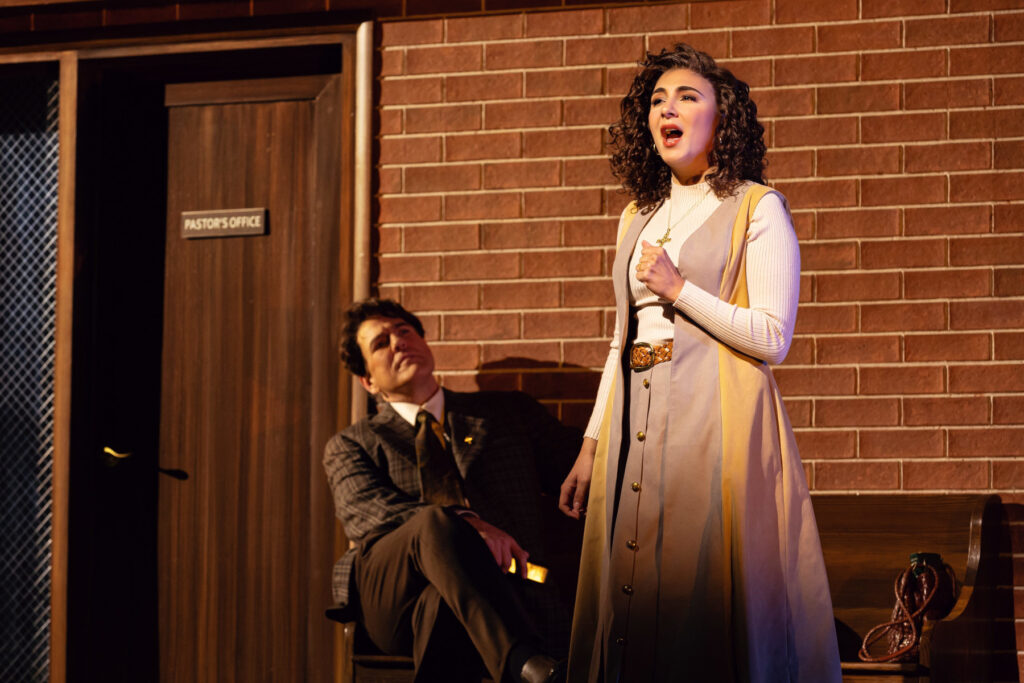
But this embarrassment of riches would mean nothing if not for the commanding control on display that is wrought by director Newbury. His skill at creating meaningful stage pictures is uncanny, and he knows how to communicate character development and relationships. Moreover, he seamlessly moves Susanne Shelton’s well-tutored chorus about the stage with purpose and precision, as they sing, play multiple roles, and move scenery. This was a fine example of stagecraft, indeed.
As the minister David, strapping baritone Michael Mayes was a force to be reckoned with and when his cavernous voice was called upon to unleash torrents of sound, he readily complied with burnished power. But Mr. Mayes is also capable of beautifully calibrated introspective effects, and he did all he could to invest David with humanity and sympathy.
While I noted the story was new, the character “type” is not, and we are already familiar with more successfully affecting scenarios of bad boy religious leaders who turn out to be bereft of morals. Try as I might, and in spite of Mayes’ wonderful gifts, and tremendous effort, I never warmed to David. That is certainly not true of the two female leads, who generated passion and pity.
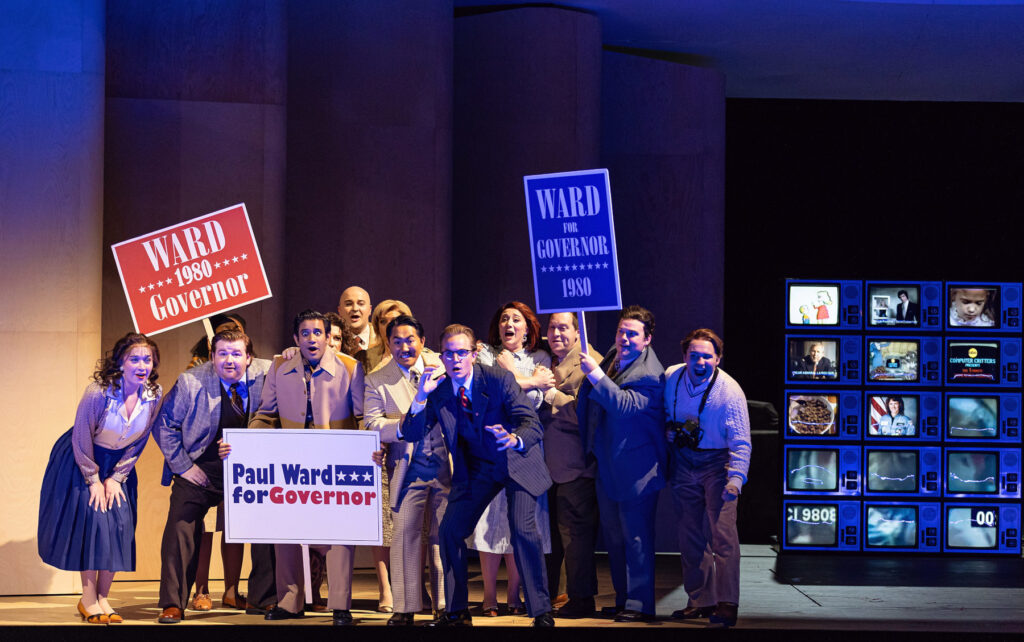
Jennifer Johnson Cano was superlative as the first wife, Sheila. Daughter of the admired governor of a state “somewhere in the Southwest” (read: Texas), David almost casually decides to marry her for her connection to power. Ms. Johnson Cano’s substantial, creamy mezzo-soprano is very persuasive in creating a complete vocal portrait of a woman in love, who processes the loss of that love, and later reconciles with her rival. Her arias were flawless combinations of radiant, poised, attractive singing invested with heartfelt delivery, and were rapturously received.
She was equaled artistically in every way by the sterling singing of soprano Elena Villalón who plays the second wife Sheila. Ms. Villalón is called upon to deliver countless floated pianissimi phrases of the type that were the hallmark of the great Montserrat Caballé and Beverly Sills, and she is every bit as skilled. Her full-bodied lyric sound was soulful and moving in its pliability and intensity. She, too, was an audience favorite, with one fan thinking she was at America’s Got Talent and ‘wooting’ for her over the ongoing music more than once.
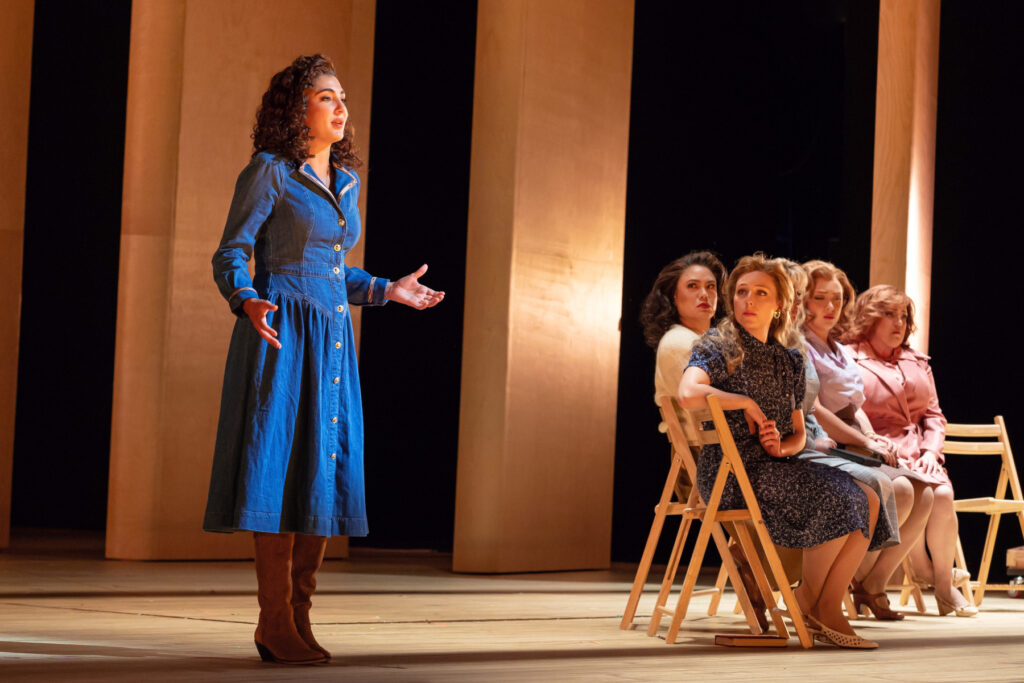
As David’s best friend and unrequited love interest Jonathan, the always solid counter tenor Anthony Roth Costanzo brought his usual professionalism to play. It was curious to me that this was scored for that voicing and seemed to convey pre-pubescence. Mr. Costanzo has had such an alluring, ethereal delivery on every other occasion I have enjoyed his singing, that here I thought the thick orchestral competition caused him to press his capabilities to the point of affecting an uncharacteristic hardness.
Santa Fe veteran Greer Grimsley was luxury casting as the Governor, known only as Paul. He has become esteemed as a pre-eminent Wagnerian, and he invested Paul with a rolling bass-baritone delivery that would not be out of place in Valhalla. As Paul doting wife, Marilyn, Wendy Bryn Harmer was a formidable matriarch, charming of demeanor and possessed of a fulsome pointed soprano. The First Family’s daughter Shannon was winningly taken by Apprentice Jazmine Saunders, whose assured soprano and acting were a fine addition to the proceedings.
Apprentice Andrew Turner’s ringing tenor fulfilled all the demands of Sheila’s first husband, Eli, a soldier whose deployment overseas facilitates the woman’s drift into adultery. Mr. Turner’s bright future seems as clear as his effortless singing. Bass-baritone Nicholas Newton was so mellifluously orotund and persistently “present” as the accusatory preacher Jacob, I wished his searing presence had been given more stage time.
In the somewhat ungrateful, functional role of the political operative, CM, tenor Brenton Ryan did all that was required while intoning his phrases with controlled, graceful outpourings. In the extraneous role of Shannon’s friend Deirdre, Apprentice Natasha Isabella Gesto nevertheless imbued her brief soprano appearance with Mozartean purity.
Since its inception, Santa Fe Opera has been lauded for championing new work in an attempt to keep the art form fresh and relevant. With this commission and World Premiere of The Righteous, they have commendably given two accomplished artists the tremendous opportunity to flex their creative muscles.
If The Righteous is not yet completely fulfilling, its many soaring moments, its contemporary food for thought, and the awesome creative teamwork on display make it worth a visit.
James Sohre
The Righteous
Music by Gregory Spears
Libretto by Tracy K. Smith
Cast and production staff:
Paul: Greer Grimsley; David: Michael Mayes; Jonathan: Anthony Roth Costanzo; CM: Brenton Ryan; Michele: Jennifer Johnson Cano; Eli: Andrew Turner; Sheila: Elena Villalón; Woman 1/Jenny; Isabel Anthony; Woman 2/Event Planner: Ashlyn Brown; Woman 3/Woman/Ruth: Tessa Fackelman; Deacon 1: Cole Bellamy; Deacon 2/Joe/Representative; Deacon 3/Young Aide: Matthew Goodheart; Marilyn: Wendy Bryn Harmer; Jacob: Nicholas Newton; Shannon: Jazmine Saunders; Deirdre: Natasha Isabella Gesto.
Conductor: Jordan de Souza; Director: Kevin Newbury; Set Designer: Mimi Lien; Costume Design: Devario Simmons; Lighting Design: Japhy Weidemann; Projection and Video Design: Greg Emetaz; Chorus Master: Susanne Sheston.
Top image: Center: Michael Mayes (David), back L – R Greer Grimsley (Paul), Brenton Ryan (CM) and Anthony Roth Costanzo (Jonathan).
All photos by Curtis Brown for the Santa Fe Opera.